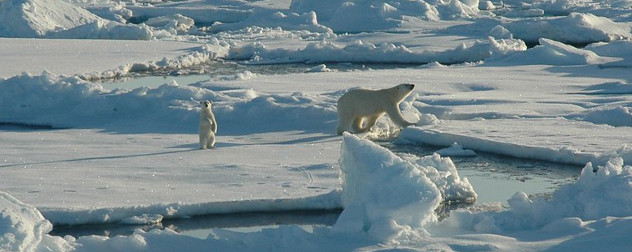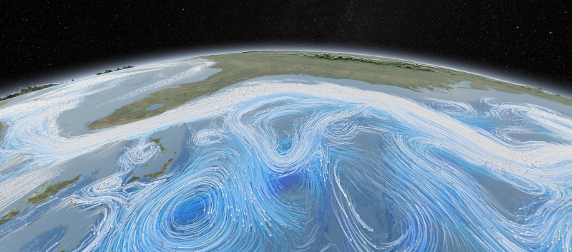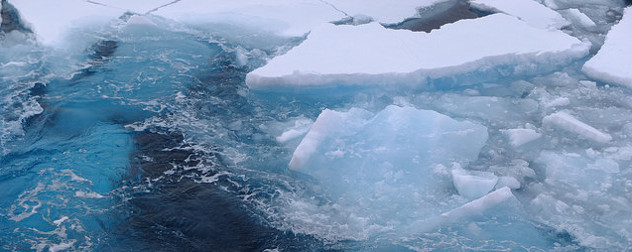The sun has just set at the top of the world, and the weather in that neck of the woods is about as lousy as you would expect. The temperature dropped to 4 degrees Fahrenheit earlier this week at the world’s northernmost outpost, Alert, in Canada’s Nunavut territory.
Another Arctic winter is coming.
Nevertheless, the high Arctic is still the epicenter of global climate change, and the scientific and policy controversies that surround the topic. Much of the region has just experienced another abnormally warm summer. Springtime snowpack was extremely low across Siberia, which set the stage for thawing breezes to blow offshore toward the Arctic Ocean’s ice pack. This followed a freakishly warm winter – part of last winter’s strong La Nina event – over Greenland and eastern Canada, which left that typically frigid locale almost devoid of sea ice last season.
The result was that the Arctic ice pack was smaller than average when the melt season started, and it declined rapidly when warm winds blew over it from Siberia. For much of the season, the National Snow and Ice Data Center (NSIDC) reported that the ice pack was at the smallest seasonal extent since regular satellite observations became available in 1979.
But the sea ice extent did not ultimately fall quite as low as the record set on Sept. 16, 2007. The NSIDC released preliminary figures this week showing that the ice pack reached its minimum on Sept. 9 at 1.67 million square miles, compared to 2007’s low of 1.61 million square miles. After touching its low for the year, the ice pack has made an unusually sharp turn upward, though it is not clear whether this is a result of early cold weather or of winds that can simply disperse the ice over a larger area of ocean.
These are the bare facts. How we interpret them depends largely on the perspectives and biases we bring to the task.
Most, though not all, of the climate science community is convinced that the reduction in Arctic sea ice, like many other phenomena such as the retreat of freshwater glaciers, is mainly the product of human-induced climate change. Reflecting this viewpoint, the NSIDC itself said this year’s low point “continues the decadal trend of rapidly decreasing summer sea ice.”
The NSIDC uses the first 22 seasons of satellite data, from 1979 through 2000, as its baseline for measuring departures from historic ice levels. During that period, the average minimum ice extent was 2.59 million square miles. The 2007 record low was 38 percent below this level – the continuation of a trend that was present even in the last decades of the 20th century, and which accelerated in the first years of the 21st.
But can we say that this year’s low marks a further progression of this trend? If we were just graphing the two data points – the minimum ice extent for 2007 and 2011 – we would observe a slight rise. The rise itself is not significant, but it calls into question whether this year’s data really represents a continuation of “rapidly decreasing” summer ice. (The NSIDC notes that other researchers, using other data sources that were not available during the baseline period, believe this year’s ice extent or volume was lower than in 2007, but there is no way to quantify long-term trends in those data sets.)
The trend line is equally unclear if we consider the results of the intervening years. In 2008, the sea ice recovered somewhat from its low point. It recovered further, and more substantially, in 2009. Then the ice pack shrank last summer back to 1.78 million square miles, a tad larger than 2008. I think the fairest way to describe the figures is that, after a period of rapid shrinkage earlier in the decade, the ice pack’s summer minimum size has fluctuated over the past four years.
This is not entirely unexpected. Researchers for the Study of Environmental Arctic Change wrote in 2008 that ice levels might fluctuate for several years until, as happened in the summer of 2007, a dramatic ice loss in a single year brings the pack to a new and lower plateau. The process would repeat itself as more time passed. Of course, if you were skeptical of the scare headlines from several summers ago that predicted the imminent demise of the ice pack, you would not be surprised to find that the floating ice has been holding its ground.
I follow developments in the Arctic for several reasons. First, I find the science interesting and the region fascinating. Second, the far northern latitudes have always been most sensitive to dramatic swings in climate, going back in recorded time to the Viking era and extending far earlier in prehistory. But mostly, I follow this because climate trends and what to do about them present one of the most important and difficult policy questions of our lifetime, one that may extend well into the adulthoods of our children and grandchildren.
Climate has always changed, often radically and sometimes suddenly. Not that long ago, geologically speaking, the great Laurentide ice sheet covered the sites of modern New York City and Chicago; a remnant persists on Canada’s Baffin Island today. Less than 13,000 years ago, as the glaciers generally retreated, a 1,300-year period known as the Younger Dryas (also called “the Big Freeze”) sent temperatures in the middle latitudes plummeting; scientists believe the change occurred in less than a decade. More recently, there was the warm period during which Iceland and Greenland were settled, the Little Ice Age that coincided with the Renaissance, and the modern period of warming.
I don’t doubt that climate changes, and I don’t doubt that human activity is a factor, given the changes in our atmosphere’s composition and in land use patterns. But I question our ability to accurately model future climate trends when we have such an imperfect understanding of historical climate shifts. And I especially doubt our political and scientific readiness to respond to climate change in ways that also recognize that the human population is 7 billion and growing and that all those people need adequate food, clean water, suitable shelter, and ways to make a living, now and in the future.
So I keep an eye each summer on the news from the far north. If the Arctic ice pack is really disappearing, it’s going to have to shrink further than it already has. The past four years have not provided much evidence either way.












September 22, 2011 - 3:04 pm
This article is bizarre. How do you justify cherry-picking two data points (2007 and 2011) to create a declining ‘trend’ ? How do you justify your assumption that, if a positive trend exists, changes must be monotonically increasing (i.e., that every year must be larger than the preceding year, or the trend does not exist)? Neither can be justified by either the science or the statistics.
Arctic sea ice is measurably decreasing, and it is decreasing faster than our models predicted. Climate change deniers like to make much of the uncertainty that climate scientists acknowledge and attempt to quantify in their models and projections. However, if you look across a range of variables, you see the same tendency as with arctic sea ice: our models and projections are more conservative than recent observations.
September 22, 2011 - 11:15 pm
Cherry picking takes many forms. One of them is picking the data points, but another is picking the series itself. After Katrina, we were assured that global warming would make wild hurricane seasons the norm. Hasn’t happened, so the topic has fallen off the AGW agenda.
Interestingly, the rise in sea level is still being used despite the lack of evidence. A quarter century ago, we were assured that global warming would cause dramatic rises in sea level by now. Instead, we have a rise of around an inch a decade, which if anything is slowing. Check http://www.aviso.oceanobs.com/en/news/ocean-indicators/mean-sea-level/.
It may be true that the recent decline in Arctic sea ice extent is worse than the models of climate “scientists” would suggest. For sea level, it’s less severe than predicted. The only constant in the prediction of climate “science” is that it’s wrong. The attempt to “quantify” this relentless error is simply a cover for the fact that this “science” is primarily speculation.
September 23, 2011 - 6:58 am
The claim that we can see an ‘increasing ice trend’ from 2007 to 2011 is exactly the same ‘logic structure’ as claiming that in the northern hemisphere if January 11th is one degree warmer than January 7th then that means temperatures get warmer during Winter.
In any case, the metric you are using is ice EXTENT… which is defined as the area of OCEAN containing at least 15% sea ice. In short, the degree to which the ice is SPREAD OUT is just as much a factor as the actual surface area of the ice. In 2007 the ice was compacted into a very small area by high winds. In 2011 the ice was much less concentrated. Yet the ‘extents’ were virtually identical. Estimates of actual ice area and volume both show 2011 well below 2007. So there was less ice in 2011 than 2007… it was just spread out more.
September 26, 2011 - 7:24 pm
I find the logic in this article to be very strange. Basically, one limited data set is used to discredit the entire climate change issue. Basically, species are migrating north in patterns never seen before. The entire planet is changing in front of my eyes. You have to be deliberately unobservant not to notice. Perhaps there is some reason other than man’s activities to blame. Who knows? To imply that it is not happening is just plain silly. I am having trouble coming up with a way to explain to my grandchildren why Santa Clause lives on a boat instead of ice.